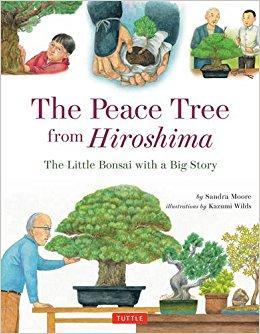
The Peace Tree
Read Aloud Book: The Peace Tree
Story: Sandra Moore
Illustration: Kazumi Wilds
ISBN-13: 978-4805313473
C3 Framework Key term: Triggering event: An event, sometimes unexpected, that has an immediate consequence, causing another event or process.
Synopsis
This story is told from the point of view of a white pine tree called Miyajima. A family that specialized in growing Bonsai trees cared for the tree for 300 years. The tree survived the atom bomb in Hiroshima in 1945. The tree’s life changed when it was given as a gift to the US for its two-hundredth birthday. The family proudly visited the tree at the National Arboretum in Washington DC.
Discussion
Show or distribute the following excerpt from U.S. Relations with Japan (US Department of State, January 25, 2017). “The United States established diplomatic relations with Japan in 1858. During World War II, diplomatic relations between the United States and Japan were severed in the context of the war that followed Japan’s 1941 attack on Pearl Harbor, Hawaii. After years of fighting in the Pacific region, Japan signed an instrument of surrender in 1945. Normal diplomatic relations were reestablished in 1952, when the Supreme Commander for the Allied Powers, which had overseen the postwar Allied occupation of Japan since 1945, disbanded. The Treaty of Mutual Cooperation and Security between Japan and the United States was signed in 1960.” Say: The bombing of Hiroshima was one of two atom bomb attacks that led to the end of World War II. President Truman authorized the use of the atom bombs to bring about Japan’s surrender. Today, Japan and the US are a model of post-war forgiveness and international collaboration. Ask: Do you think that the tree in this story can be used as a metaphor? What would the tree symbolize? Show the illustrations in the book and say: A bonsai (pronounced “bones-eye”) means a “tree in a pot.” Bonsai tree symbolize harmony between one’s soul and his/her natural environment. Harmony is represented through the aesthetics of the tree. Character strength is represented through the tree’s age and resilience.
Ethics Connection
Say: After World War II, both Japan and Germany adhered to ethical principles of foreign policy, including: (1) cooperating with other countries to address common challenges; (2) focusing on nonmilitary means to achieve national goals; (3) promoting supranational organizations such as the United Nations; (4) supporting human rights and international law; and, (5) renouncing weapons of mass destruction. In groups, select one of these five principles, and create a short presentation about the ethical value of this principle. You may use the following examples: World Health Organization (principle 1); The Organization for Economic Co-operation and Development (OECD) (principle 2); United Nations Educational, Scientific, Cultural Organization (UNESCO) (principle 3); United Nations Human Rights (principle 4); North Atlantic Treaty Organization (NATO) (principle 5).
Fun Activity
Distribute copies of the United States Department of Agriculture Tree Coloring Challenge. Say: Bonsai masters show great patience and perseverance when they care for the Bonsai trees. This tree challenge invites you to demonstrate the same virtues. At home, color the tree and pay close attention to all the fine details of the tree. Bring your work to class to share in our tree gallery.